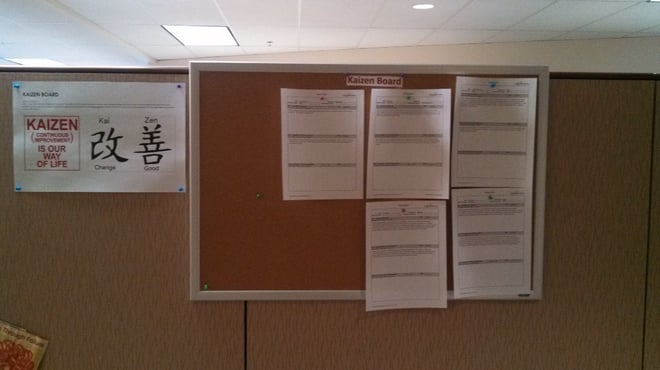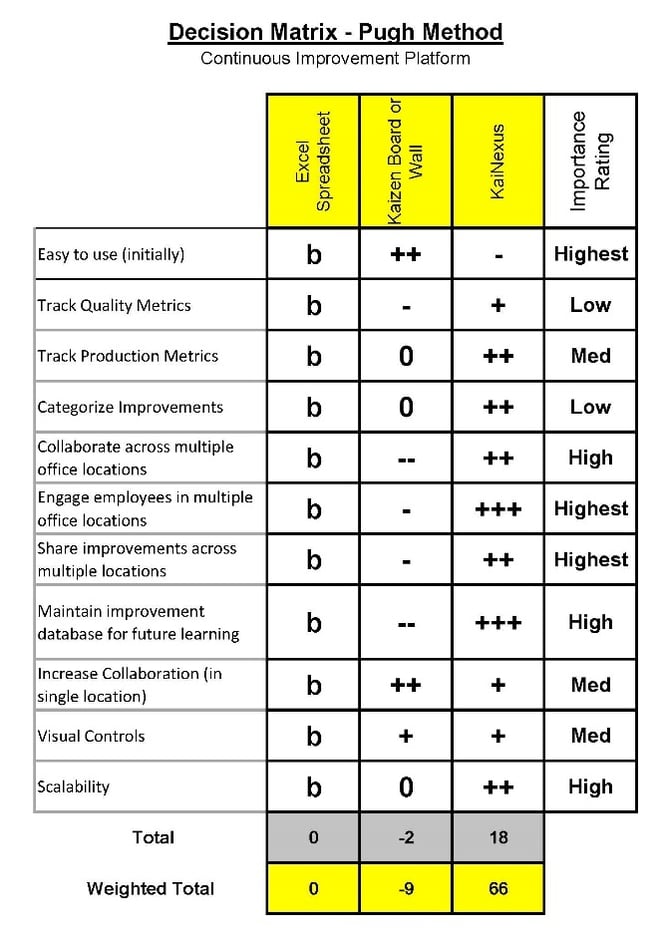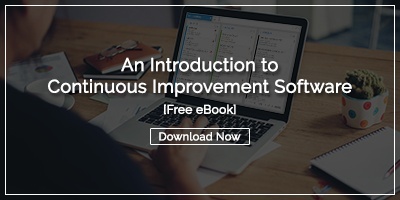When we first began Kaizen, or Continuous Improvement, at BSA LifeStructures, we used a Kaizen Board in a common area to engage one Engineering team of ten to twelve people. Ideas were put on a Kaizen sheet and shared at staff meetings. This took the place of meetings we used to call “Lessons Learned” where people would share mistakes, poor installation, communication gaffes, etc. but none of that was recorded. The Kaizen Board gave us a much-needed way to capture those things, share them with our group, and allow others in the company to stop by our Kaizen Board to possibly learn from our experience.

After 4-5 months, the entire Engineering Department wanted to join. At this point, we went from 12 to 50 people. We decided we needed a way to track and store the Kaizens that people were submitting.
This is when we moved to using an Excel Spreadsheet to track multiple data points. This proved to be a very time-consuming task. Eventually the leaders did not maintain the spreadsheet, failed to provide feedback to their staff, and the wheels started coming off. Additionally, I relocated from our headquarters in Indianapolis to Austin, which made it much more difficult to stay engaged and help foster the culture we had started. Within four months of bringing on the other Engineering teams, Kaizen was on life support.
"Within four months of bringing on the other Engineering teams, Kaizen was on life support."

The saving grace was people were still talking about the Kaizen Board, which was still hanging in the office, and how they could start that in their own departments, like Architecture, Construction Administration, Civil and Accounting. I seized the opportunity by assembling a group of leaders from those departments to discuss Kaizen.
The result of that 1.5 hour discussion was an A3, which listed goals and began an implementation plan to create a company-wide Continuous Improvement effort. It listed some of the failures and why we felt they had occurred. We all agreed the key to making this successful was finding a software solution that would allow us to:
- Meet our goals
- Correct the mistakes we made with the spreadsheet experiment
- Track data to help Continuous Improvement sell itself
- Allow employees in a company spread across seven different locations to engage and collaborate with one another and to store all the ideas for future learning.
WOW, that’s a lot!
Luckily for us, I knew Mark Graban from an IPD project in Indianapolis, and had seen him talking about KaiNexus on LinkedIn and Twitter. When I first looked at their website, I figured that a software program was way more than we needed, assumed it was too expensive (even though I had no idea), and was really just a way to make Mark’s work easier…. Boy, was I wrong!
This was the exact solution we were looking for to address all of the items we felt were “must-haves.” After a demo for myself, I engaged our senior leadership. They quickly realized the potential, and we received approval to move forward with KaiNexus. Early on in the selling process to my senior leadership, I created a decision matrix that was meant to show the advantages of a software versus previous solutions. That matrix is below:
"This was the exact solution we were looking for to address all of the items we felt were must-haves."

We began a phased implementation of KaiNexus in April of 2015 and achieved full implementation by June 2015. To date, we have over 110 improvement ideas and have an estimated labor savings of over $325,000.
We are still learning about continuous improvement and bettering our improvement process. I have blogged about the importance of Methodology when doing continuous improvement, and I feel that is where we have to concentrate our effort now that we have Leadership and the Technology to support continuous improvement.
Continuous improvement software provided us with the robust, sustainable solution that we needed to support improvement when Kaizen Boards and spreadsheets failed, and I recommend that anyone experiencing similar problems look into KaiNexus.
About the Author:
 Jake Snyder is a design engineer at BSA LifeStructures, and is one of the firm’s staunchest advocates for Lean implementation on design projects. Jake has also been an office leader in the firm’s own adoption of Lean principles. A Lean Healthcare Yellow Belt and Six Sigma Green Belt, Jake has already created measurable improvement using Lean methods at one of the nation’s premiere healthcare projects, the Simon Family Tower project at Riley Hospital for Children at IU Health. Jake is recognized for his work within complex environments that require creative, high-performance engineering solutions.
Jake Snyder is a design engineer at BSA LifeStructures, and is one of the firm’s staunchest advocates for Lean implementation on design projects. Jake has also been an office leader in the firm’s own adoption of Lean principles. A Lean Healthcare Yellow Belt and Six Sigma Green Belt, Jake has already created measurable improvement using Lean methods at one of the nation’s premiere healthcare projects, the Simon Family Tower project at Riley Hospital for Children at IU Health. Jake is recognized for his work within complex environments that require creative, high-performance engineering solutions.



Add a Comment